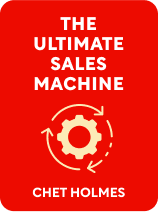

This article is an excerpt from the Shortform book guide to "The Ultimate Sales Machine" by Chet Holmes. Shortform has the world's best summaries and analyses of books you should be reading.
Like this article? Sign up for a free trial here .
What attributes should you look for when screening candidates for your sales team? What do you think is more important in sales success—personality or experience?
Building a great team is the cornerstone to an effective sales operation. With the right talent, your business can grow exponentially. With bad hires, you’ll find yourself throwing money away and constantly treading water.
Here are three keys for assembling the sales team of your dreams.
1. Find People With the Right Personality
The first step to building a sales team is to find people with the right personality. Specifically, you want people who have the right mix of self-confidence, pride, determination, and persuasiveness. If someone has the right attitude and psychological disposition, it doesn’t matter if they have no sales experience.
According to Holmes, these are the people who will consistently advocate for themselves and their company when talking to customers, will have the ambition and force of personality to drive sales, and won’t back down in the face of rejection (which they’ll surely encounter a lot in the world of sales).
| Personality vs. Experience: Top Entrepreneurs Weigh In The subject of whether to hire based primarily on experience or personality is a controversial one. Indeed, some of the world’s top entrepreneurs are split on the question. Virgin Group founder Richard Branson favors hiring based on personality, emotional intelligence, and cultural fit with the company. Branson argues that, while job-specific knowledge can always be taught, the emotional or temperamental attributes that make someone a good or bad fit for a position are innate. For Branson, if someone has the wrong personality, no amount of training can overcome that. On the other hand, Robert Herjavec, founder and CEO of the Herjavec group (and one of the judges on Shark Tank) says that a candidate’s skillset and level of focus are the most important attributes when it comes to hiring decisions. Herjavec says that an interview needs to be structured to help the interviewer distinguish between good performers and those who are merely good at presenting themselves in interviews. |
2. Re-Think Your Interview Style
Thus, you need to design your interview and recruitment process to identify these candidates. During an interview prescreen, for example, you should aggressively challenge them on whether or not they really have what it takes to join your team. Holmes even recommends being forward and saying things like, “Your sales track record sounds pretty weak. I need top performers, not dime-a-dozen salespeople. You haven’t told me anything so far that would really convince me you can make it with us.”
It might sound harsh, but Holmes writes that people with the right blend of pride and confidence will forcefully push back when you needle them like that—and that’s the exact kind of pushback you’re looking for.
| Be Careful About Asking Personal Questions In his book The Ultimate Sales Machine, Holmes recommends asking personal, probing questions to get a deep sense of a candidate’s personality. He even advises asking questions that are highly unusual within the context of a professional interview. For example, he says to ask a candidate about their childhood, parents, and formative experiences in youth, claiming that this will give you unparalleled insight into how confident and self-assured they are. While Holmes does caution against asking certain questions that are illegal in an interview (at least in the United States)—such as about a candidate’s age, race, gender, national origin, or family status—asking about someone’s childhood as Holmes recommends could be construed as coming dangerously close to asking about one of these protected statuses. Further, according to experts, such questions can 1) be deeply traumatic for those who experienced painful childhoods, 2) create a bias against people from non-traditional family-of-origin backgrounds (such as those raised by same-sex parents or single parents), and 3) be psychologically unsound—because unless you’re a trained psychologist, you as an interviewer are unlikely to be able to make informed decisions about someone’s personality based upon your analysis of their childhood. |
3. Motivate With Commissions
Once you hire the right people, Holmes recommends giving them the right incentives. That’s why he advocates using a commission-based pay structure to motivate your sales team. You offer them a relatively low base salary but promise them that they can earn many times more than that if they help grow the business.
If you’ve hired people with the right personality, this should be all the incentive they need. Best of all, they’ll grow your customer base for you and you pay them directly out of the new business they bring in.
| The Downside to Commissions Some sales experts think that the value of a commission-based pay structure is overrated. In Drive, Daniel H. Pink argues that there are significant drawbacks to commissions. When you’re paying commissions, you often have to devise a whole set of complicated rules and procedures to prevent salespeople from gaming the commission system. For example, if you award commissions based on the number of sales, your reps might have an incentive to simply close a lot of deals at below-market rates to boost their figures—benefiting them, but hurting the company. Pink also argues that commission-based sales teams often promote poor morale and teamwork, because salespeople at the same company are more likely to view one another as competitors rather than colleagues—which can lead to undercutting and rivalries that ultimately harm the business as a whole. |
Optimize Your Team With Training
Once you’ve hired the right people, continue to raise their skill level through mandatory and regular training. This helps you set consistently high standards and prepares employees for any situation.
(Shortform note: Some companies do their sales training in-house, while some hire an outside consultant like Holmes to conduct these sessions. But even if you have to pay for it initially, the training will reap rewards that will more than recoup your investment. In Sell or be Sold, Grant Cardone writes that simply closing the sales you’re currently missing through inadequate training alone will justify the costs.)
Maximize Effectiveness With Interactive Training
But, Holmes cautions, not just any training will do. It needs to be consistent, regular, interactive, and fun. One-off annual training events where employees are simply lectured to for a few hours isn’t going to have any lasting impact. Real skill-building, writes Holmes, comes when employees are engaged in the training and participating in shaping their experiences as they’re learning. Role-playing exercises can be great for this, helping your sales team direct their own education while working through thorny real-life scenarios.
(Shortform note: Some firms make role-play training a regular part of company life. In Peak, Anders Ericsson offers up the example of Blue Bunny Ice Cream. This company used its regular meetings between regional sales managers and the senior sales manager to stage role-playing exercises, in which the regional sales manager practices making their pitch to a customer and receives feedback on their approach. Ericsson writes that this not only helps refine the skills needed for the next call with a customer, but it also gets everyone in the company used to the idea of practicing and training itself—because it just becomes a normal part of the business day.)
Crowdsource Problem-Solving
Another tactic Holmes recommends is crowdsourcing problem-solving. At a training, the CEO or team leader identifies a common problem affecting the company’s performance. She can present the problem through a PowerPoint presentation and then solicit everyone across the company for their input on solutions. They can even separate into breakout groups to discuss and debate potential solutions. After the breakout sessions conclude, the leader then collects the ideas and presents them to the entire meeting.
Then, there is a public vote on the results, where participants select their favorite ideas. The winning ideas can then be implemented as part of a pilot program where they’re tested and refined to see what works best.
(Shortform note: This technique can be highly effective and scalable—indeed, it’s done by some of the best-known companies in the world. In Creativity, Inc., Ed Catmull notes that Pixar uses crowdsourcing through its famed “Notes Day.” On Notes Day, Pixar shuts down regular operations and runs a variety of discussion forums based on a wide range of topics submitted by employees. Pixar leaders use this information to surface problems they may not have noticed and then crowdsource solutions to them.)

———End of Preview———
Like what you just read? Read the rest of the world's best book summary and analysis of Chet Holmes's "The Ultimate Sales Machine" at Shortform .
Here's what you'll find in our full The Ultimate Sales Machine summary :
- How to build a first-rate sales operation
- Why it's better to be an expert at a few things instead of adequate at a lot
- Why you should get rid of your "open door" policy






